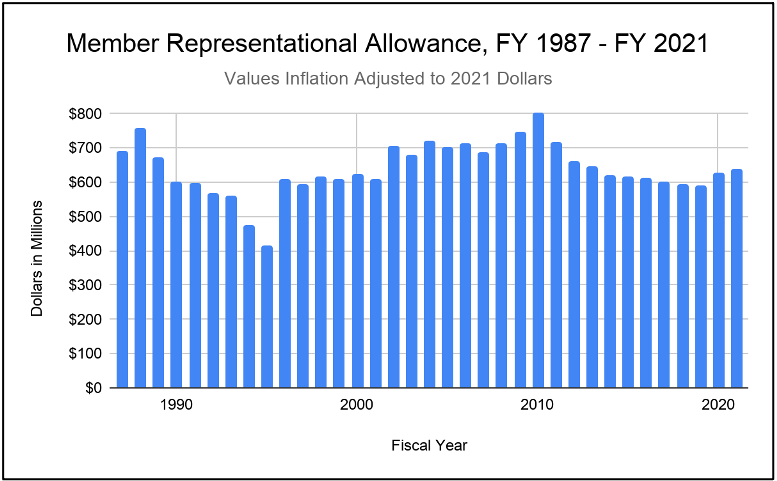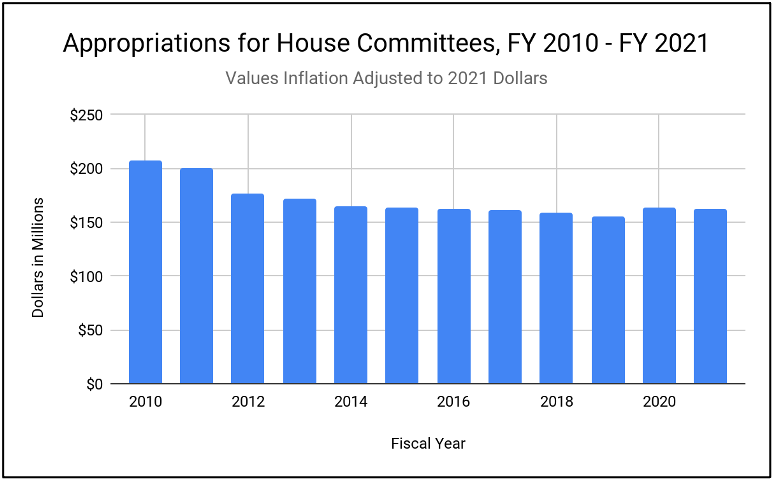| The Honorable Rosa DeLauro Chair House Committee on Appropriations H-307, The Capitol Washington, DC 20515 |
The Honorable Kay Granger Ranking Member House Committee on Appropriations H-307, The Capitol Washington, DC 20515 |
Re: In support of a 20% increase in the House Member Resource allocation and increased committee funding
Dear Chair DeLauro and Ranking Member Granger:
We urge the House of Representatives to restore funding levels for Members Representational Allowances (MRA) and House committees to their FY 2010 levels, as adjusted for inflation. This would help address high turnover among congressional staff by addressing the twin issues of low pay and an unsustainable workload.
Members of both parties have spoken out about this problem, and expressed support for sensible adjustments to the MRA. House Majority Leader Steny Hoyer (D-MD) and Democratic Caucus Chair Hakeem Jeffries (D-NY) expressed their support for a 20% increase to MRAs.[1] House Modernization Committee Vice Chair Timmons (R-SC) has argued for an increase in funding for the Legislative Branch in excess of 10%[2], and Rep. Betty McCollum (D-MN) spoke eloquently before the House Select Committee on the Modernization of Congress on the difficulties of retaining experienced staff.[3] And the late Elijah Cummings (D-MD), in his capacity as Chairman of the House Oversight Committee, testified during the last Congress about ways in which funding cuts have hindered bipartisan oversight of waste, fraud, and abuse.[4]
Providing staff appropriate compensation for their work and ensuring sufficient staff levels in offices are essential to retain expert staff, promote staff diversity, and ensure sufficient staff expertise. Unfortunately, the House of Representatives made double-digit percentage cuts to funding levels for personal and committee oversees over the last quarter century.
From FY 2010 to FY 2021, funding for MRAs has decreased by just over 20%, or $161.7 million dollars, adjusted for inflation. This is illustrated in the chart below, which shows the past 34 years. Furthermore, unlike the Senate, the House does not provide rebalance funding for constituent services staff based upon population growth in the district, so workload per staffer has increased even as the maximum number of staff has held constant.

The decrease in funding can also be seen at the committee level. From FY 2010 to FY 2021, funding for House Committees has decreased by nearly 21.4%, or $44.5 million, adjusted for inflation.[5] The chart below reflects this decrease in funding.

Funding levels for personal and committee office staff are unsustainably low. They have created a crisis that is overwhelming the staff that work in the halls of Congress, not to mention the Members and committees that they support. While restoring funding for the House committees to FY 2010 levels will not resolve the issue, it will make an appreciable difference. It would help to stabilize the current situation while the House enacts additional policies to strengthen its ability to recruit and retain a capable and diverse workforce.
Thank you for your consideration. We welcome the opportunity to discuss this further. Please contact Daniel Schuman, Policy Director for Demand Progress at [email protected], or Zach Graves, Head of Policy for the Lincoln Network at [email protected].
Sincerely,
American Family Voices
Bipartisan Policy Center Action
College to Congress
Congressional Management Foundation
Consumer Action
Courage California
Demand Progress
Democracy Fund Voice
Government Accountability Project
GovTrack.us
Indivisible
Institute for Democratic Engagement & Accountability (IDEA) at the Ohio State University
Issue One
Joint Center for Political and Economic Studies
Lincoln Network
NALEO Educational Fund
National Security Counselors
New Jersey Association on Correction
NIskanen Center
Partnership for Public Service
Pay Our Interns
Professional Managers Association
Progress America
Project On Government Oversight
Protect Democracy
Rachel Carson Council
Revolving Door Project
RootsAction.org
Senior Executives Association
Win Without War
Kevin Kosar, American Enterprise Institute*
Norman Ornstein, American Enterprise Institute*
Robert Cook-Deegan, Arizona State University*
Lorelei Kelly, Beeck Center for Social Impact + innovation at Georgetown*
Todd Wells, Federal Managers Association*
Casey Burgat, George Washington University*
Samantha Feinstein, Government Accountability Project*
Mike Miesen, Harvard Kennedy School’s Belfer Center*
Kevin M. Esterling, University of California, Riverside*
John Leary, DotGov.com*
Rick Shapiro, Strategic Assets Consulting*
* Affiliations listed for identification purposes only.
cc:
Representative Tim Ryan, Chair of the Legislative Branch Subcommittee on Appropriations
Representative Jamie Herrera Beutler, Ranking Member of the Legislative Branch Subcommittee on Appropriations
Members of the House Committee on Appropriations
[1] Letter from Congressman Steny Hoyer (MD-05) and Congressman Hakeem Jeffries (NY-08) To House Appropriators, April 28, 2021 https://www.majorityleader.gov/sites/democraticwhip.house.gov/files/HOYER-JEFFRIES%20STAFF%20PAY%20AND%20BENEFITS%20LETTER%204-28-2021.pdf
[2] Comments of House Modernization Committee Vice Chair William Timmons at a Hearing on Boosting Internal Expertise in Congress, June 26, 2020 at 53:16 https://youtu.be/-hExfpd_BrA?t=3196
[3] Testimony of Congresswoman Betty McCollum (MN-04) Before The Select Committee on the Modernization of Congress Member Day Hearing, April 15, 2021 https://docs.house.gov/meetings/MH/MH00/20210415/111434/HHRG-117-MH00-Wstate-M001143-20210415.pdf
[4] Testimony of Chairman Elijah E. Cummings Before The Committee on House Administration, March 12, 2019 https://docs.house.gov/meetings/HA/HA00/20190312/109052/HHRG-116-HA00-Wstate-C000984-20190312.pdf
[5] For additional information on the FY 2022 committee funding numbers, see “How House Committees Get Their Money”, The First Branch Forecast, April 28, 2021 https://firstbranchforecast.com/2021/04/28/how-house-committees-get-their-money-2/

